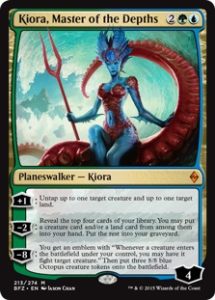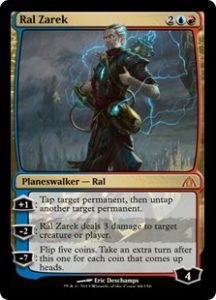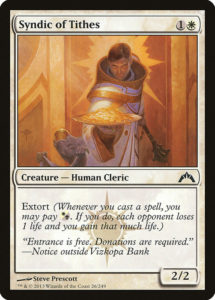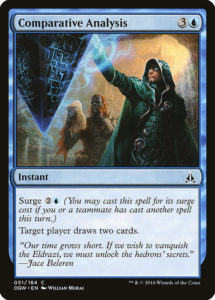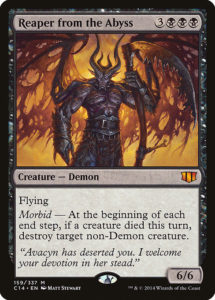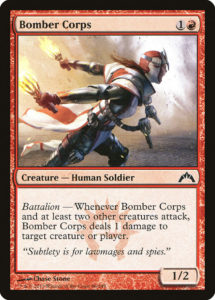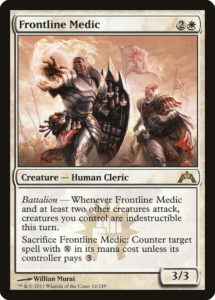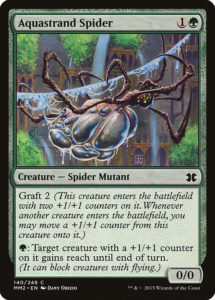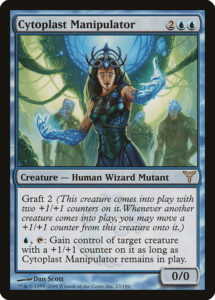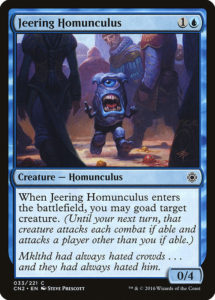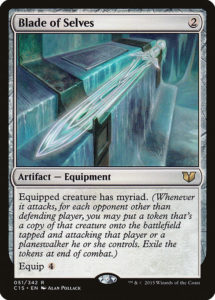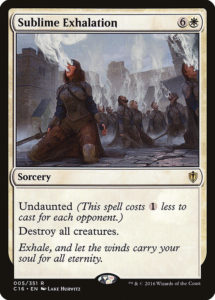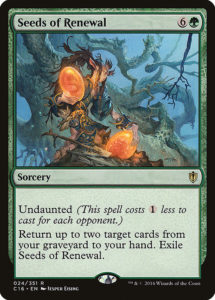You’ve dethroned monarchs, assembled contraptions, and chased planes. You might have even successfully teamed up to take down an elder dragon.
But what if you had to deal with TWO powerful foes – or perhaps find yourself the one setting schemes into motion against an equally-diabolical rival? Enter Archfrenemies.
What is Archfrenemies?
Archfrenemies is both a Cube and Archenemy variant for eight players (that’s right – playing all at once). With a curated card pool and new rules, this is a play experience like other “draft innovation” sets such as Conspiracy, Unstable, & the upcoming Battlebond set.
If you’re a fan of casual Magic with a large group of friends, this might be a format you’ll enjoy.
Gameplay
Teams
Two players are each an archenemy (“Archenemy A” and “Archenemy B”). The other six players each belong on one of two teams of three (Red Team and Blue Team). With four distinct entities, your goal is to be the last archenemy or team left standing.
NOTE: The archenemies are not on the same team. A whole team wins when a team outlasts the archenemies and the other team with at least one surviving teammate.
Seating
Teammates sit next to each other while the archenemies each sit between teams.
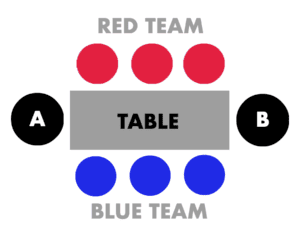
Starting the Game
Each player gets one free mulligan. The first player draws a card on their first turn. The two archenemies randomly determine who between them goes first.
The scheme cards (from Archenemy and Archenemy: Nicol Bolas) are shuffled together then split in half into a scheme deck for each archenemy.
Archenemies start with 40 life while teammates start with 20 life each.
“Outside the Game”
All players have what is known in other multiplayer formats (i.e. Emperor) as a “range of influence.” This refers to how many players to the left or right of you you’re able to affect with your spells, abilities, and attacks. In Archfrenemies, each player’s range of influence is two.
Within the context of Archfrenemies, any players within the range of influence are referred to as being “in the game” while those that are not are “outside the game.”
In the Archfrenemies Cube, there are cards involving people “outside the game.” Whether it’s Side Quest or Defective Detective, Archfrenemies repurposes the handful of included “outside assistance” cards to only be able to choose players playing Archfrenemies that are “outside the game” (outside your range of influence).
Playing as the Archenemy
When an archenemy takes their turn, as the first main phase of their turn begins, they set a scheme in motion from their scheme deck.
As an archenemy, the number of opponents you have is four – the two players closest to you from each team. The furthest player for each of Red Team and Blue Team are out of your reach – at least, at the beginning of the game.
Conversely, the other archenemy can reach these players furthest from you but not the ones closest to you. The center teammate for each of Red Team and Blue Team are shared opponents between you and the other archenemy.
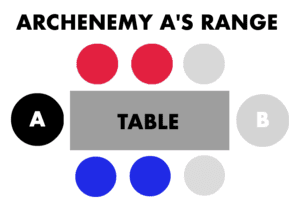
Playing as a Team
When either Red Team or Blue Team take their turn, all players within the team take their turn at the same time, going through each phase and step together as well as announcing attackers at the same time.
However, each member of the team reach different opponents. With the range being two, all teammates can reach each other for their spells’ and abilities’ effects.
Team Center
At the start of the game, this teammate can reach each of the archenemies but none of the players on the other team.
Team Flank
At the start of the game, this teammate, whether to the left or right of the team’s center, can only reach the opponents that is the archenemy closest to them and the flank of the other team closest to them.
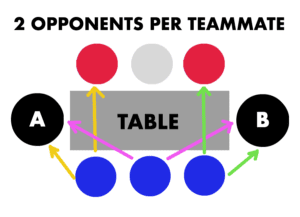
Blocking
When attacked as a team member, teammates can block for you with their creatures. Unlike Archenemy, the players that can have their creatures block for you are limited to the range of the player attacking you.
From the beginning of the game, when attacked by an archenemy, the flank teammate closest to the archenemy and the center teammate can block for each other. When the other team’s flank attacks a flank teammate, no other teammates are in range of the attacker to help with blockers.
Drafting
Role Cards
Before drafting the Archfrenemies Cube, seat each player for draft randomly then deal each player a random role card.
NOTE: Seating for roles only matters after draft decks are built.
During the draft, only you can look at your role card. This role card helps inform the kind of cards you want to draft as there are cards that are more beneficial for teammates and vice versa.
The role cards are: Archenemy A, Archenemy B, Red Team – Left Flank, Red Team – Center, Red Team – Right Flank, Blue Team – Left Flank, Blue Team – Center, Blue Team – Right Flank
During and After Draft
Draft three packs of fifteen cards each per player. Once the draft is complete, players reveal their role cards and build their decks. The teams can view each of their teammates’ card pools but cannot swap cards amongst each other. Minimum deck size for the draft decks is forty.
Pack Composition
Each pack contains the following cards: 10 commons, 3 uncommons, 1 rare/mythic, 1 nonbasic land. One in every three packs has a “foil” (they aren’t actually foil), which replaces a common and may be of any rarity.
Cube Contents
While I would love to go into detail the decisions going into the Archfrenemies Cube’s design, that is another blog post for another time. Here’s the list:
CubeTutor List
http://www.cubetutor.com/archfrenemies
CubeTutor Visual Spoiler
http://www.cubetutor.com/visualspoiler/99404
Contents
For each unique card in the Cube list, there are multiple copies of it in the Cube, as follows:
- Common: five copies
- Uncommon: three copies
- Rares and Mythics: two copies
Mechanics
There are five prominent mechanics to draft around in the Cube, one for each enemy color pairing. Additionally, there are three other mechanics on a few cards to utilize the unique gameplay of this format. They are:
Extort
The power of this mechanic increases when you’re playing as the archenemy – you’ll have up to four opponents’ life totals to drain versus the two that each of the teammates only have.
Surge
With two other players on your team helping to enable surge, you’ll find yourself more easily being able to sling spells for their discounted price.
Morbid
With up to five players “in the game,” there’s sure to be a lot of destroyed creatures. Take advantage of all the death with morbid cards.
Battalion
When battalion is utilized by a member of a team, note that the trigger checks for any attacking creatures – not just your own! Take advantage of battalion triggers as teammates.
Graft
This ability allows you to affect ANY creature entering the battlefield – not only ones entering under your control. A great choice for a supporting teammate.
Goad
In a multiplayer format, sometimes you need to “encourage” others’ creatures to swing sideways – just not at you!
Myriad
Get the most bang for your buck as the archenemy and attack with a myriad creature to get up to three more token copies created and attacking your opponents.
Undaunted
Sure, archenemies are outnumbered – but taking on the teams is not so scary when using undaunted cards.
Pack Construction
Before a draft:
- Shuffle one copy of every unique card into a Singleton Pile.
- Shuffle the rest of the nonland commons into a Commons Pile. Repeat this process for uncommons, rares, & mythics; respectively.
- Shuffle ALL the lands into the Land Slot Pile.
- From the Singleton Pile, randomly deal eight cards into a Foil Slot Pile
- From the Commons Pile, randomly shuffle sixteen cards into the Foil Slot Pile.
- From the Rares Pile, randomly deal twenty-one cards into the Rare Slot Pile
- From the Mythics Pile, randomly shuffle three cards into the Rare Slot Pile
- Randomly deal into a Pack:
- Nine cards from the Commons Pile
- Three cards from the Uncommons Pile
- One card from the Rare Slot Pile (not the Rares Pile)
- One card from the Land Slot Pile
- One card from the Foil Slot Pile
- Repeat Step 8 for each of the twenty-three remaining packs to construct
Alternatively, shuffle up every card and make random fifteen-card packs. It’ll probably be close enough. 😉
Of Schemes and Teams
While the Cube was tailor-made for Archfrenemies, you might want to try out the format itself using your schemes with your own Cube or Brawl/Commander games (if you do, tweet me your pics and stories at @bradleyrose). If you wanna try out the whole package, catch me at GP Vegas!
Header image: Bradley Rose

Bradley is a co-host of a weekly Magic: The Gathering design podcast, Beacon of Creation. He was among the Top 101 contestants in Wizards of the Coast’s Great Designer Search 2. He enjoys crafting custom Magic product experiences, like Archfrenemies, and building Commander decks with creative constraints.



